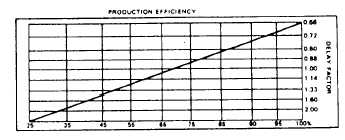The man-hours per unit on the work sheet is obtained by dividing the total man-days shown in the detail estimate by the total feet of concrete pipe times the unit to obtain the average man-hours. The man-hours per unit should be used for checking actual progress. You should check manpower estimates against the activity estimate to ensure that no activities have been omitted. NAVFAC P-405 provides labor estimates for the various projects undertaken by the Engineering Aids.
The Facilities Planning Guide, NAVFAC P-437, volumes 1 and 2, is an excellent source for preliminary estimates. Use it to find estimates for a wide range of facilities and assemblies commonly constructed. The P-437 not only gives the man-hours required, but it also gives a breakdown of the construction effort by ratings (BU, CE, UT, and so forth) as well as lapsed day estimates.
You must bear in mind that the lapse time from the P-437 is calculated using the contingency norm of a 10-hour man-day instead of the 8-hour man-day used in the P-405. For example, a specific task from the P-437 requires 100 man-hours (MH) of effort by the Utilitiesman. The optimum crew size is four UTs. This yields the following lapse time:

Using the P-405 and an 8-hour man-day, you will find that the same task yields the following:

In preparing manpower estimates, weigh the various factors affecting the amount of labor required to construct a project. These include weather conditions during the construction period, skill and experience of personnel who will perform the work, time allotted for completing the job, size of the crew to be used, accessibility of the site, and types of material and equipment to be used.
The production efficiency guide chart (table 9-2) lists eight elements that directly affect production. Each production element is matched with three areas for evaluation. Each element contains two or more foreseen conditions from which to select for the job in question. Evaluate each production element at some percentage between 25 and 100, according to your analysis of the foreseen conditions. The average of the eight evaluations is the overall production efficiency percentage. Now, convert the percentage

Figure 9-7. - Production efficiency graph.
to a delay factor, using the production efficiency graph (figure 9-7). It is strongly recommended that the field or project supervisors reevaluate the various production elements and make the necessary adjustments to man-day figures based on actual conditions at the jobsite.
NOTE
The estimate of average Seabee produc- tion used in the NAVFAC P-405 tables falls at 67-percent production efficiency on the graph shown in figure 9-7. As you see, this repre- sents a delay factor of 1.00. A delay factor of 0.66 represents peak production efficiency, equivalent to 100 percent.
In reading the graph, note that the production elements have been computed into percentages of production efficiency, which are indicated at the bottom of the graph. First, place a straightedge so that it extends up vertically from the desired percentage, and then place it horizontally from the point at which it intersected the diagonal line. You can now read the delay factor from the values given on the right-hand side of the chart. Let's look at an example of the process of adjusting man-hour estimates.
Assume that from the work estimate taken from the tables in P-405, you find that 6 man-hours are needed for a given unit of work. To adjust this figure to the conditions evaluated on your job, assume that the average of foreseen conditions rated by you is 87 percent. The corresponding delay factor read from the production efficiency graph is 0.80. You find the adjusted man-hour estimate by multiplying this delay factor by the man-hours from the estimating tables (6MH x 0.8 = 4.8 as the adjusted man-hour estimate).
The man-hour labor estimating tables are arranged and grouped together into the 16 major divisions of work. This is the same system used to
Continue Reading